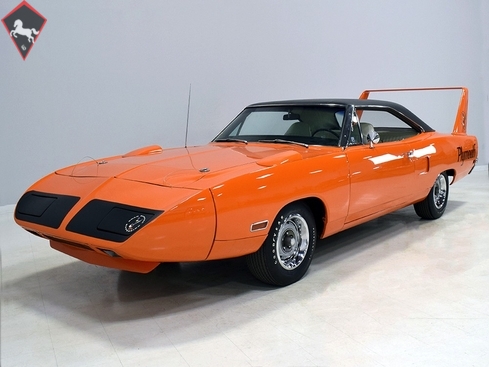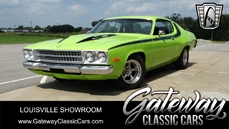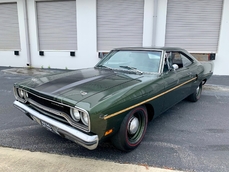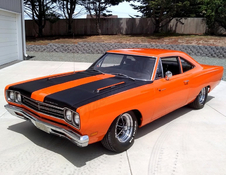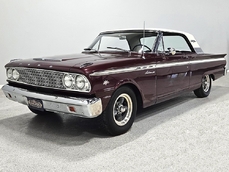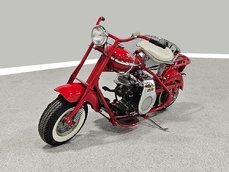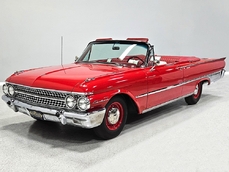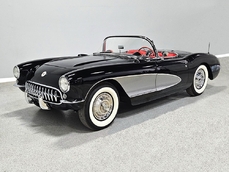Plymouth Roadrunner 440 cubic inch V8 1970
Allgemeine Beschreibung :
The wind has been the catalyst for some of the greatest designs in automotive history: Chrysler Airflow, Bugatti Atalante, Pierce-Arrow Silver Arrow, Tucker Torpedo, Porsche 356, Alfa-Romeo BAT series—there are dozens of designs that have become iconic simply because they were born to cheat the wind. Yet in America during the 1960s, when gas was cheap and our industrial might was undisputed, aerodynamics were forgotten and instead we focused on size and power, trying to prove that we could conquer the wind rather than harness it. We eventually learned, however, that if you want to win races, the wind must be your ally. And as with the Airflow, Chrysler understood it before most of the competition and became the first manufacturer to build a 200 MPH NASCAR racer.
The mighty “wing cars,” the Dodge Daytona and Plymouth Superbird, were controversial just as every aerodynamic experiment before them. But their continued existence today only proves that good design endures. While they were difficult to sell when they were new, they are among the most highly-sought vehicles of the muscle car era and are unquestionably the kings of the super speedways. They did it by making the wind work for them, not against, and it worked.
This 1970 Plymouth Superbird has never turned a wheel in anger on a big oval, but it remains iconic in every sense of the word. Famous at a glance, with the power and performance to back up the legend, the Superbird stands head and shoulders above almost every one of its peers. If you are a Mopar collector without one of these in your collection, you are not a Mopar collector. It is THE shining example of Chrysler’s single-minded pursuit of speed.
That may seem like a lot of introduction for such a familiar face, but it’s critically important to put the Superbird into context. This isn’t just some weird Mopar, it’s THE Mopar, the car that proved once and for all that Chrysler was not playing around when it came to winning races. In person, the car is simply stunning, from the pointed nose to the towering wing and when it’s covered in Vitamin-C Orange paint, it is impossible to ignore. This particular Superbird hails from Texas, where it spent the first years of its life (we have a detailed ownership history on the car tracking its movements around the country). As a result, the sheetmetal is unmarked and in fantastic condition, particularly following a high-quality repaint just recently. There’s just no way these cars fit together this well when they were new, particularly given their hand-built nature, so someone obviously invested a great deal of time and money to get it to look this good. The nose lines up neatly with the fenders, the unusual extended hood snugs down flush when you insert the hood pins, and the doors close with authority—kerCHUNK! And yes, the headlights work properly, although they can be a little lazy at times. We can find no evidence of rust or previous accident repairs, and the car appears to be wearing all its original sheetmetal and floors, which is a rather are thing all by itself. Don't worry, all the unique Superbird details are intact and properly represented. This car is right.
Finding a code P6XW white interior inside a Superbird is unusual but not unheard-of, and it is indeed how this car was originally ordered. The fender tag confirms this, but since it’s a Lynch Road car, the codes are kind of wonky, although it does also confirm bucket seats, a C16 console, the V19 black vinyl top that was unique to the Superbirds, and the EK2 Vitamin-C paint code, of which only 91 were built. We find the bright white upholstery to be very welcoming and it’s brand new, so it just sparkles inside the bright orange ‘Bird. Almost everything you can touch is new, including seat covers, door panels, carpets, and even the dash pad and headliner. The car is equipped with Rallye gauges—and they all work—as well as a set of more accurate Auto Meter dials down on the console for temperature and oil pressure. Only the tachometer is inoperable, but we have not investigated that situation. There’s also an unusual AM/8-track radio, surprising for a Superbird, most of which were lightly optioned. Embroidered floor mats will help keep it looking its best and the trunk is outfitted with a reproduction mat. You’ll note that the heavy-duty support stanchions for the wing are still in place—that wing is reportedly strong enough to support a grown man sitting on it, although I don’t think I’d care to test that claim.
This Superbird also carries its original, numbers-matching 440 cubic inch V8 engine. The cowl tag says that it was originally topped by a 4-barrel carburetor, but as with many Mopars, somewhere along the way it acquired a complete and correct Six Pack setup, which is always a desirable addition (the original 4-barrel carburetor and intake manifold are included with the car). According to the notes in the car’s file, the engine was rebuilt in 1993, which was less than 3000 miles ago, so it remains quite fresh and runs superbly. The carbs are well-tuned so there’s no stumbling or rough idle, and the secondaries come online smoothly without a big hit, just the way they’re supposed to. Aside from a few details, the engine bay is quite correct, with a proper Six Pack air cleaner assembly, Hemi Orange paint on the engine itself, and those wild cast iron exhaust manifolds that go up and over the top of the ports. Power steering and power disc brakes were standard on the Superbird, which is probably a good idea, and all the hardware under the hood is faithful to the original. Change the hose clamps and the ignition wires, and it would look almost totally stock.
Most Superbirds came with a Torqueflite 3-speed automatic transmission, which is what you’ll find here (denoted by code 670 on the fender tag). Rebuilt when the engine was rebuilt, it features a shift kit that firms up the shifts and allows the burly 440 to ram through the gears without incident. There’s torque everywhere on the map and the transmission is always read with a quick downshift, making this Superbird, truly, um, super on the road. You’re not likely to go unnoticed, but this car remains a real threat for even more modern hardware. Code 052 on the fender tag means there are 3.55s in the 8.75-inch rear end, and that’s a good ratio for the street, giving it plenty of punch yet cruising easily at 70 MPH. The undercarriage is quite original and I respect the choice of previous owners to not over-restore it. Instead, it proudly shows off a total absence of rust or rot, almost perfect factory floors, clean seams and spot welds, and rock-solid rocker panels. This is a zero-issue Mopar that’s in fantastic condition for driving and enjoying as intended. Factory Rallye wheels with trim rings are unmarked and carry optional F60-15 Goodyear Polyglas bias-ply tires for the right 1970s look.
Documentation includes a partial Chrysler Corporation Broadcast Sheet, ownership records dating back to new, and some period brochures and ordering information.
This is A-list muscle, you know it. Finding these cars has become increasingly difficult and prices are skyrocketing as enthusiasts realize the ultimate Mopar has been overlooked for far too long. This is an outstanding example with just enough originality to make it special and enough restoration to make it a machine that you’ll be proud to own. Fully sorted, a blast to drive, and still an absolute traffic-stopper, the Plymouth Superbird is unlike anything else you can own. Call today!
http://www.harwoodmotors.com/vehicles/inventory_details.php?id=880
1970 Plymouth Roadrunner 440 cubic inch V8 is listed verkauft on ClassicDigest in Macedonia by for $169900.
Fakten der Auto
Karosserietyp : Auto Marke : Plymouth Modell : Roadrunner Ausführung : 440 cubic inch V8 Hubraum : 0.0 Modelljahr : 1970 Lage : Ohio
Verkauft
Angaben Zum Verkäufer
Verkauft
People who viewed this Plymouth Roadrunner also viewed similar Plymouth listed at ClassicDigest
Other cars listed for sale by this dealer
über Plymouth
Die Marke Plymouth hatte von Anfang an einen erheblichen Einfluss auf die Automobilindustrie bis zu ihrer letztendlichen Absendung. Hier ist ein Überblick über Plymouth, der seine Geschichte, bemerkenswerte Modelle und Spezifikationen abdeckt:Frühe Jahre und Stiftung:
Origins (1928): Plymouth wurde von der Chrysler Corporation als erschwingliche Marke mit mittlerer Ebene vorgestellt, die sich auf budgetbewusste Verbraucher zielte.
Erfolgsfaktoren: Aufgrund seiner zuverlässigen Technik, Erschwinglichkeit und cleveren Marketingkampagnen erlangte es Beliebtheit.
Bemerkenswerte Modelle:
Plymouth Road Runner (1968-1980):
Ikone Muscle Car: Bekannt für seine Leistung, Erschwinglichkeit und minimalistisches Design.
Spezifikationen: Bieten Sie verschiedene V8 -Motoroptionen mit Strom von 335 bis 390 PS an.
Plymouth Barracuda (1964-1974):
Muscle Car -Konkurrent: positioniert als sportlicher Konkurrent im Muscle Car -Segment.
Spezifikationen: Die Motoroptionen umfassten V8s mit Ausgangsleistung zwischen 145 und 425 PS.
Plymouth Fury (1955-1978):
Langlebigkeit: Eines der am längsten produzierten Modelle von Plymouth, die in verschiedenen Körperstilen erhältlich ist.
Technische Funktionen: Motoroptionen umfassten V8s mit Strom von 215 bis 375 PS.
Plymouth Valiant (1960-1976):
Kompaktes Auto: Eingeführt als kompaktes Auto, bekannt für seine Haltbarkeit und Zuverlässigkeit.
Motorspezifikationen: Inline-Six- und V8-Motoren mit Strom von 100 bis 235 PS.
Niedergang und Niedergang:
Spätere Jahre: Plymouth stand vor Herausforderungen aufgrund der Markenverdünnung innerhalb der Chrysler Corporation und dem zunehmenden Wettbewerb durch andere Marken.
Abbruch: Die Marke hatte in den neunziger Jahren zu kämpfen, da die Unternehmensumstrukturierung und der sinkende Umsatz zurückgegangen sind. Plymouth stellte 2001 im Rahmen von DaimlerChryslers Straffungsbemühungen die Produktion ein.
Vermächtnis und Auswirkungen:
Plymouths Vermächtnis liegt in seinen Beiträgen zur amerikanischen Automobillandschaft und bietet zuverlässige, erschwingliche und stilvolle Fahrzeuge. Während es in seinen späteren Jahren Herausforderungen stand und letztendlich die Produktion einstellte, bleiben einige seiner ikonischen Modelle, insbesondere diejenigen in der Muscle -Car -Ära, unter Sammlern und Enthusiasten und hinterlassen eine dauerhafte Marke für die Automobilgeschichte.
